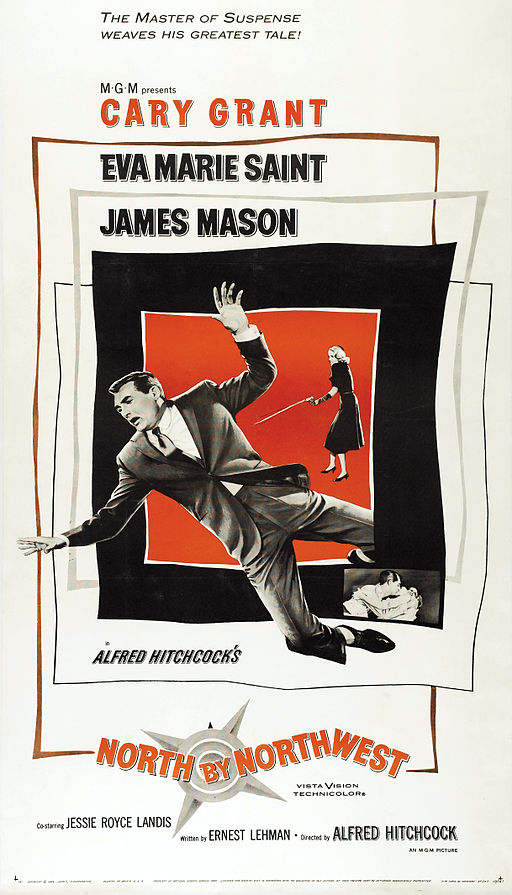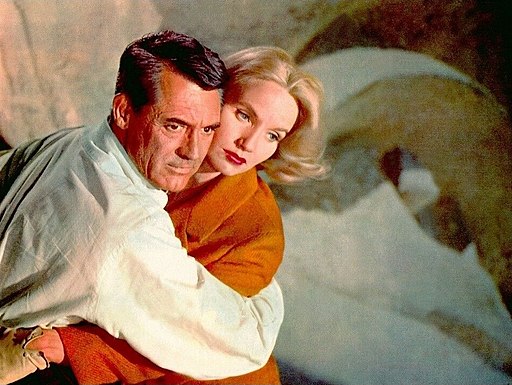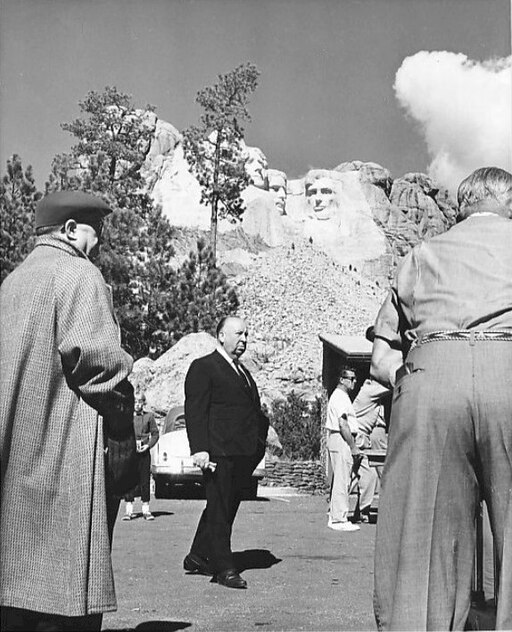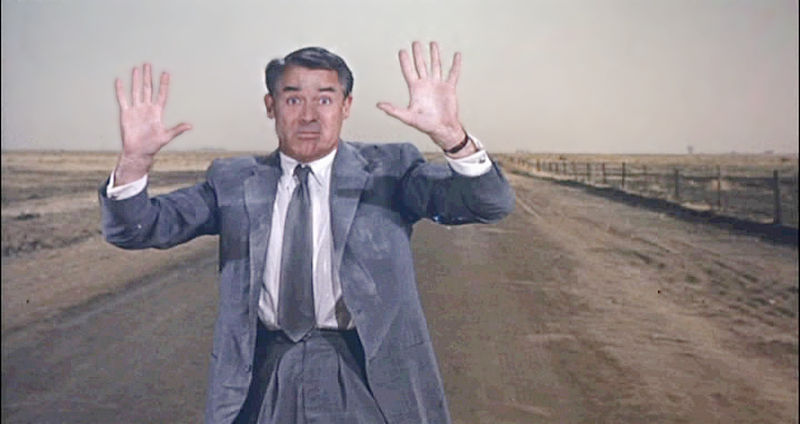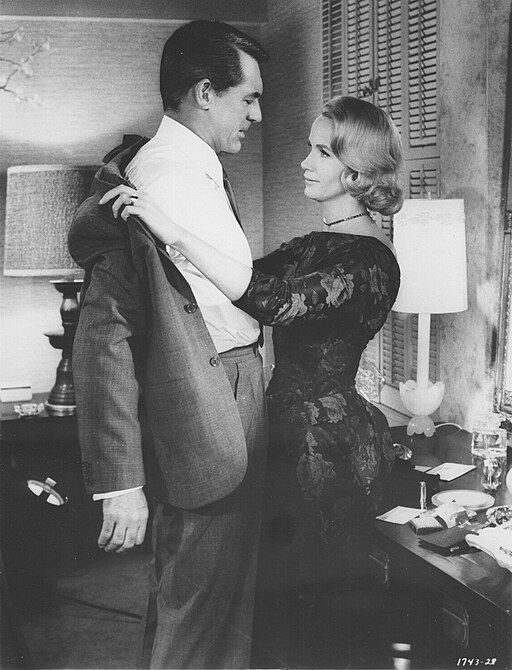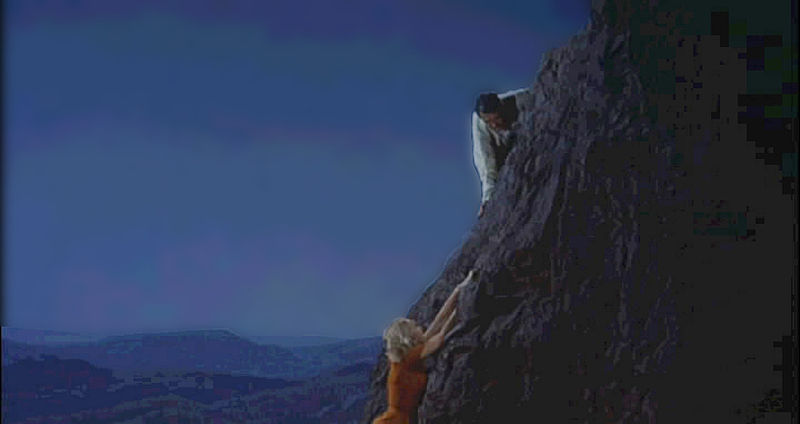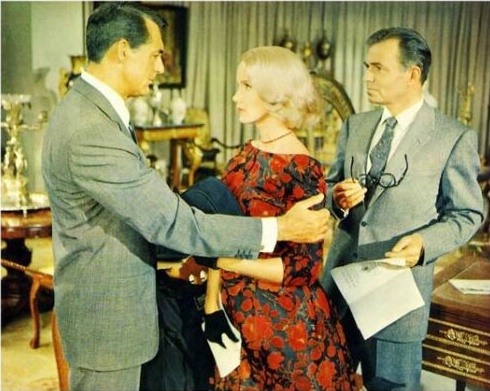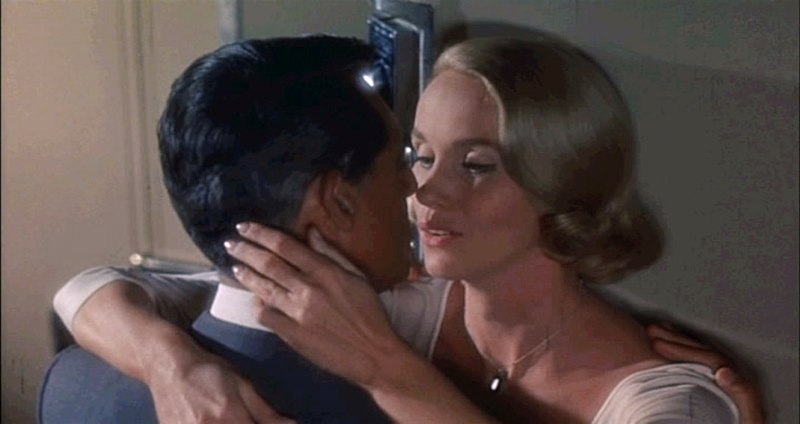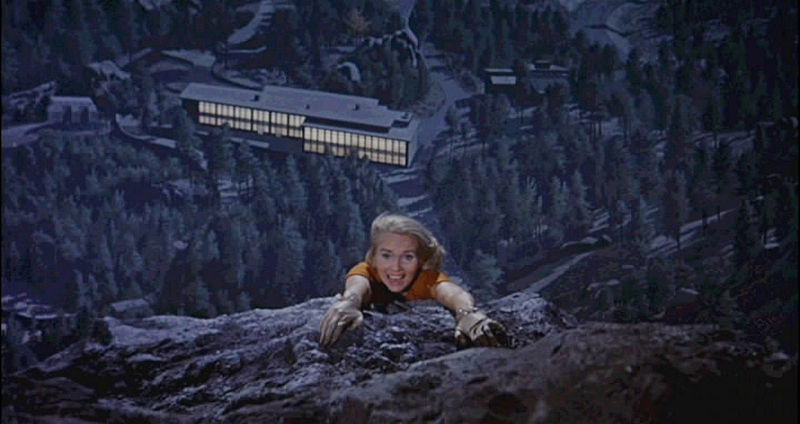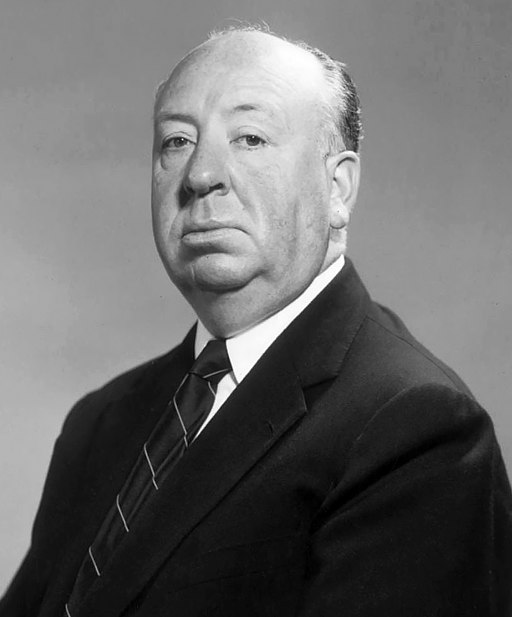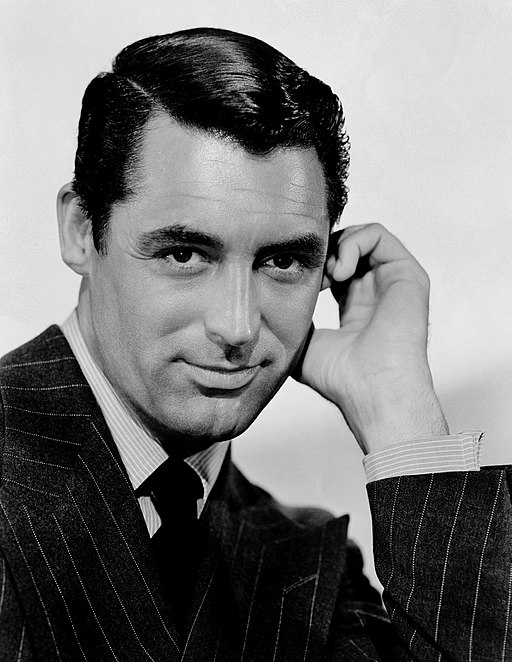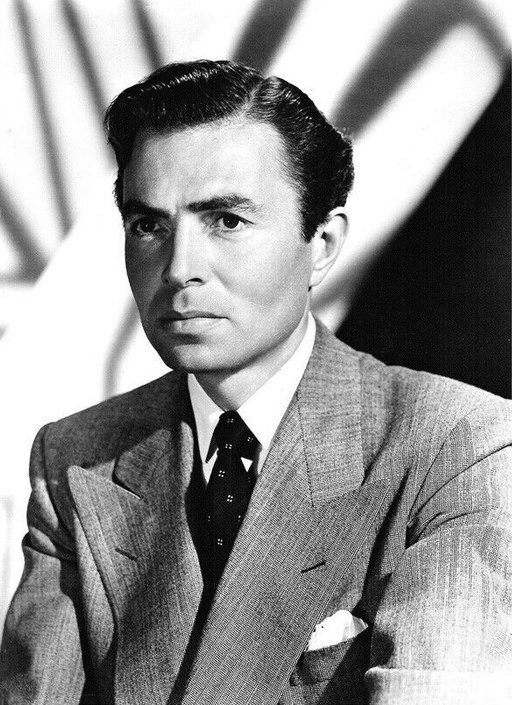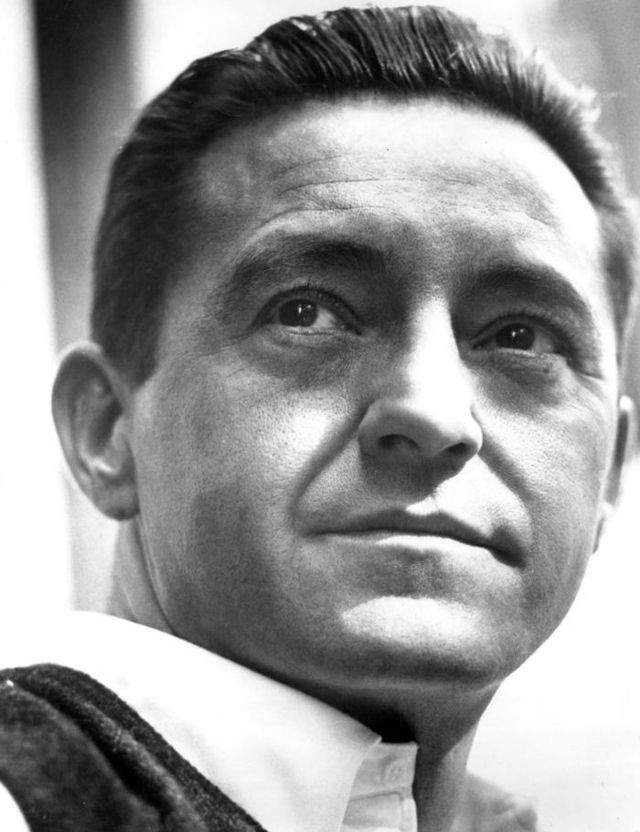North by Northwest - 1959
back| Released by | Metro-Goldwyn-Mayer |
| Director | Alfred Hitchcock |
| Producer | Alfred Hitchcock |
| Script | Screenplay by Ernest Lehman |
| Cinematography | Robert Burks |
| Music by | Bernard Herrmann |
| Running time | 136 minutes |
| Film budget | $3.1 million |
| Box office sales | $13.3 million (initial release) |
| Main cast | Cary Grant - Eva Marie Saint - James Mason - Jessie Royce-Landis - Leo G. Carroll |
North by Northwest
A thrilling and stylish masterpiece of intrigue
"North by Northwest" (1959), is a seminal work in the thriller genre, often hailed as one of Alfred Hitchcock's masterpieces. The film is known for its sophisticated plot, witty dialogue, and innovative cinematography.
It tells the story of Roger Thornhill, an advertising executive who is mistaken for a government agent and becomes entangled in a cross-country chase filled with intrigue, romance, and iconic suspenseful set pieces.
The film's use of famous landmarks, like Mount Rushmore and the United Nations building, its memorable music score by Bernard Herrmann, and the crisp, engaging script by Ernest Lehman, contribute to its status as a classic.
"North by Northwest" is not only a critical success but also a fan favorite, known for its blend of suspense, humor, and stylish direction. It remains an influential film in both Hitchcock's body of work and the broader thriller genre.
Related
North by Northwest
Complete Overview and Analysis
Narrative and Themes
- Mistaken Identity: The film’s plot revolves around the concept of mistaken identity, with Cary Grant’s character, Roger Thornhill, being mistaken for a government agent. This leads to a series of thrilling and dangerous situations.
- Espionage and Pursuit: The film expertly blends elements of espionage with a cross-country pursuit, keeping the tension high throughout. The narrative is tightly woven, with each scene propelling the plot forward.
- Romance and Intrigue: Alongside the suspense, there’s a romantic subplot involving Thornhill and Eve Kendall (Eva Marie Saint), which adds depth and complexity to the story.
Direction and Style
- Hitchcock’s Mastery: Hitchcock’s direction is a key element of the film’s success. His ability to create suspense out of ordinary situations and his meticulous attention to detail are evident throughout.
- Visual Storytelling: The film is noted for its innovative use of visuals, including the famous crop duster scene and the climax at Mount Rushmore. Hitchcock’s use of these iconic American settings adds a sense of grandeur to the film.
Cinematography
- Innovative Techniques: Robert Burks’ cinematography is remarkable, using dynamic camera angles and movement to heighten the sense of suspense and urgency. The use of VistaVision also contributes to the film's visual impact.
- Symbolic Use of Landscapes: The landscapes and settings, from the UN building to Mount Rushmore, are not just backdrops but play an integral role in the narrative, symbolizing various aspects of the plot.
Performances
- Cary Grant: Grant’s portrayal of Thornhill is iconic, bringing charm and a touch of humor to the role. His performance as the suave but bewildered advertising executive caught in a deadly game is central to the film’s appeal.
- Supporting Cast: Eva Marie Saint provides a strong performance, adding both romance and intrigue. James Mason, as the antagonist, and Martin Landau, as his henchman, contribute significantly to the film’s tension.
Music
- Bernard Herrmann’s Score: The music score by Bernard Herrmann is integral to the film’s atmosphere. The score enhances the suspense and complements the action, becoming a character in its own right.
Cultural Impact
- Defining Hitchcock Film: "North by Northwest" is often considered one of Hitchcock’s definitive works, encapsulating many elements of his style – suspense, humor, and a sophisticated plot.
- Influence on the Genre: The film set a high standard for the thriller genre and influenced numerous films that followed. Its blend of action, suspense, and humor was particularly innovative for its time.
Legacy
- Enduring Popularity: The film’s ongoing popularity is a testament to its mastery. It continues to be celebrated for its narrative, stylistic innovation, and Hitchcock’s direction.
Full Cast of “North by Northwest”:
- Cary Grant as Roger O. Thornhill
- Eva Marie Saint as Eve Kendall
- James Mason as Phillip Vandamm
- Jessie Royce Landis as Clara Thornhill
- Leo G. Carroll as The Professor
- Josephine Hutchinson as Mrs. Townsend
- Philip Ober as Lester Townsend
- Martin Landau as Leonard
- Adam Williams as Valerian
- Edward Platt as Victor Larrabee
- Robert Ellenstein as Licht
- Les Tremayne as Auctioneer
- Philip Coolidge as Dr. Cross
- Patrick McVey as Sergeant Flamm
- Edward Binns as Captain Junket
- Ken Lynch as Charley - Chicago Policeman
Analysis of the Direction of Alfred Hitchcock:
Alfred Hitchcock's direction of "North by Northwest" is a masterclass in suspense, storytelling, and cinematic technique, firmly establishing the film as one of the pinnacles of his career. Here's an analysis of his directorial approach:
Mastery of Suspense
- Building Tension: Hitchcock's signature style of building suspense is evident throughout the film. He expertly crafts scenes that escalate tension, often through the use of dramatic irony where the audience knows more than the characters.
- Innovative Set Pieces: The film includes some of Hitchcock's most iconic and memorable set pieces, such as the crop duster attack and the climactic scene on Mount Rushmore. These sequences are masterfully constructed to maximize suspense and visual impact.
Visual Storytelling
- Creative Camera Work: Hitchcock's use of the camera is innovative and purposeful. His framing, camera angles, and movement all serve to enhance the storytelling. He employs a variety of techniques, from expansive aerial shots to tight close-ups, to control the viewer's focus and emotional response.
- Symbolic Imagery: The director uses visual motifs and symbolism to add layers to the narrative. For instance, the recurring motif of lines and crosses serves to symbolize Thornhill's entrapment and pursuit.
Narrative Pacing and Structure
- Pacing: Hitchcock maintains a brisk pace throughout the film, keeping the audience engaged and on edge. Even in moments of relative calm, there is an underlying tension that drives the story forward.
- Structural Precision: The film is structured with precision, balancing action, romance, and humor. Hitchcock carefully orchestrates the narrative to ensure a seamless and cohesive experience.
Characterization
- Complex Characters: Hitchcock draws complex and intriguing characters, led by Cary Grant's suave yet vulnerable Roger Thornhill. The director ensures that characters are not just plot devices but have depth and dimension, making them relatable and memorable.
- Subtle Humor: Hitchcock infuses the film with a subtle humor that complements the suspense. This is particularly evident in the witty banter between Thornhill and Eve Kendall (Eva Marie Saint).
Use of Music
- Collaboration with Bernard Herrmann: The film's score, composed by Bernard Herrmann, is integral to its atmosphere. Hitchcock and Herrmann's collaboration results in a musical backdrop that heightens the suspense and enriches the cinematic experience.
Influence and Legacy
- Defining the Thriller Genre: "North by Northwest" is often cited as a defining film in the thriller genre, showcasing Hitchcock's ability to blend suspense, action, and romance in a highly entertaining package.
- Innovative Techniques: Hitchcock's techniques in this film, from the use of visual effects to narrative structure, have influenced countless filmmakers and remain a study in effective cinematic storytelling.
In summary, Alfred Hitchcock's direction in "North by Northwest" is a showcase of his skills as a master of suspense and a pioneer in film technique. His ability to combine a compelling narrative with technical prowess and psychological depth makes "North by Northwest" a timeless classic and a landmark in the history of cinema.
The Influence of Cinematographer Robert Burks:
Robert Burks, as the cinematographer for "North by Northwest," played an integral role in shaping the film's visual style and overall impact. His collaboration with Alfred Hitchcock was crucial in bringing Hitchcock's vision to life and establishing the film as a cinematic masterpiece. Here’s an analysis of Burks' contribution and importance to "North by Northwest":
Visual Storytelling
- Cinematic Aesthetics: Burks' cinematography is characterized by its crisp, vibrant aesthetics. His use of color and composition in "North by Northwest" adds depth and intensity to the film's visual narrative. The striking visuals are not just pleasing to the eye but also contribute significantly to the storytelling.
- Iconic Shots: Some of the film's most iconic images, like the crop duster sequence and the climactic chase across Mount Rushmore, showcase Burks’ ability to create tension and drama through visuals. His framing and camera movements in these sequences are masterful.
Enhancing Suspense and Atmosphere
- Building Tension: Burks’ use of camera angles and movement plays a key role in building suspense, a hallmark of Hitchcock’s films. By carefully choosing his shots, Burks was able to amplify the sense of danger and urgency in key scenes.
- Atmospheric Lighting: Burks' lighting techniques contribute to the film's atmosphere. He skillfully uses lighting to create mood, highlight characters, and enhance the film's dramatic effect.
Creative Collaboration with Hitchcock
- Understanding Hitchcock’s Vision: Having worked with Hitchcock on several films, Burks had a deep understanding of the director’s visual style and preferences. This understanding allowed for a seamless creative collaboration that is evident in the film’s meticulous composition.
- Technical Innovation: Burks was known for his willingness to experiment with new techniques and technologies. His innovative approach aligned well with Hitchcock’s desire to push cinematic boundaries.
Influence on Film Language
- Setting a Standard: The cinematography in "North by Northwest" set a new standard for action and suspense films. Burks' techniques in handling complex action sequences, and his ability to use visuals to advance the plot, influenced subsequent generations of filmmakers.
- Integration of Visuals and Story: Burks demonstrated how cinematography could be seamlessly integrated into the narrative, enhancing the storytelling without overshadowing it.
Awards and Recognition
- While Burks did not win an Academy Award for "North by Northwest," his work on the film is widely celebrated and remains a benchmark for excellence in cinematography.
In summary, Robert Burks’ contribution as the cinematographer of "North by Northwest" is of immense importance. His skillful visual storytelling, innovative techniques, and effective collaboration with Hitchcock were crucial in creating the film's suspenseful atmosphere and iconic visual style. His work on the film is not only a testament to his talent but also a significant part of what makes "North by Northwest" a timeless classic in the thriller genre.
The Vandamm House near Mount Rushmore:
The climactic scenes of "North by Northwest," set against the backdrop of Mount Rushmore, are among the most iconic in film history.
However, it's important to note that the house where these final scenes take place, often referred to as the Vandamm house, was not an actual residence located near Mount Rushmore. Instead, it was a creation of the filmmakers, designed to add to the suspense and drama of the movie's conclusion. Here's a closer look at this aspect of the film:
The Vandamm House
- Fictional Location: The house, owned by the film's antagonist Phillip Vandamm (played by James Mason), is a fictional location. It was designed to provide a luxurious and isolated setting for the film's climax.
- Set Design: The house was a set constructed by the filmmakers. Its design was modernist, featuring large glass windows and an expansive living area, which provided a stark contrast to the natural ruggedness of Mount Rushmore.
- Strategic Placement for the Plot: The placement of the house near Mount Rushmore served a narrative purpose. It provided a dramatic setting for the film's final confrontation and escape scenes.
Filming and Production Design
- Use of Studio and Models: The scenes were filmed using studio sets and scale models. Due to restrictions on filming at Mount Rushmore, the production team could not film the house or the characters directly on the monument. Instead, they used clever camera angles, models, and matte paintings to create the illusion that the characters were interacting with the actual monument.
- Artistic License: The decision to create a fictional house near Mount Rushmore was an example of artistic license by Alfred Hitchcock and his team. It allowed for a more dramatic and visually compelling climax than would have been possible if restricted to the actual locations around the monument.
Symbolism and Impact
- Suspense and Drama: The Vandamm house, with its modern architecture and remote location, added an element of intrigue and suspense, which is a hallmark of Hitchcock's films.
- Iconic Cinema Moment: The final sequence at the Vandamm house and on Mount Rushmore has become one of the most memorable in cinema, known for its combination of suspense, action, and visual innovation.
Remarkable Quotes from “North by Northwest”:
Roger Thornhill (Cary Grant): "I don't like the way Teddy Roosevelt is looking at me."
- This line is delivered by Thornhill while being held at the Townsend estate, showcasing Hitchcock's blend of suspense with a touch of humor.
Thornhill: "The moment I meet an attractive woman, I have to start pretending I have no desire to make love to her."
- A line that reflects Thornhill's charm and the film's romantic tension.
Thornhill: "In the world of advertising, there's no such thing as a lie. There's only expedient exaggeration."
- This quote gives insight into Thornhill's character and his career in advertising.
Eve Kendall (Eva Marie Saint): "I never discuss love on an empty stomach." Thornhill: "You've already eaten." Kendall: "But you haven't."
- This exchange between Thornhill and Kendall showcases the film's clever and flirtatious dialogue.
Thornhill: "I'm an advertising man, not a red herring. I've got a job, a secretary, a mother, two ex-wives, and several bartenders dependent upon me, and I don't intend to disappoint them all by getting myself slightly killed."
- A humorous line that encapsulates Thornhill's wit and the absurdity of his situation.
The Professor (Leo G. Carroll): "War is hell, Mr. Thornhill, even when it's a cold one."
- This line reflects the broader geopolitical context of the Cold War era in which the film is set.
Thornhill: "How does a girl like you get to be a girl like you?" Kendall: "Lucky, I guess."
- Another example of the flirtatious and witty banter between Thornhill and Kendall.
Thornhill: "Apparently, the only performance that will satisfy you is when I play dead." Phillip Vandamm (James Mason): "Your very next role, and you'll be quite convincing, I assure you."
- A tense exchange that underscores the danger Thornhill faces.
Analysis of Cary Grant’s Performance as Roger Thornhill:
Cary Grant's portrayal of Roger Thornhill in "North by Northwest" is a standout performance that combines charm, wit, and a subtle undercurrent of vulnerability.
Charismatic Everyman
- Relatable Protagonist: Grant's Roger Thornhill is an everyman swept up in extraordinary circumstances. He's a successful but somewhat superficial advertising executive who is mistaken for a government agent. Grant's portrayal makes Thornhill both relatable and likable, despite his initial superficiality.
- Charm and Sophistication: Grant's natural charisma and sophistication are key to the character. His smooth demeanor and quick wit provide much of the film's humor and keep the audience engaged and sympathetic to his plight.
Evolution of Character
- Growth and Depth: Throughout the film, Thornhill evolves from a man primarily concerned with his own comfort and reputation to someone who takes courageous action. Grant skillfully navigates this character arc, showing Thornhill's transformation while maintaining the core aspects of his personality.
- Vulnerability: Grant infuses Thornhill with a sense of vulnerability, particularly in situations where he's out of his depth. This vulnerability adds depth to the character and contrasts effectively with his otherwise polished exterior.
Mastery of Suspense and Comedy
- Balance of Genres: Grant’s performance strikes a perfect balance between the suspense inherent in the plot and the comedic elements of Thornhill's character. His ability to deliver lines with a comedic edge without undermining the tension is a testament to his skill as an actor.
- Physical Comedy: In addition to verbal wit, Grant's physicality and expression contribute to the film's lighter moments, providing comic relief in a story filled with intrigue and danger.
Chemistry with Co-stars
- Romantic Dynamics: Grant's scenes with Eva Marie Saint (who plays Eve Kendall) are charged with a mix of romance and danger. His chemistry with Saint adds a compelling romantic subplot to the film.
- Interaction with Antagonists: Grant’s interactions with the film’s antagonists, especially James Mason as Phillip Vandamm, are marked by a clever interplay that adds to the film’s suspense.
Iconic Hitchcock Hero
- Quintessential Hitchcockian Lead: Thornhill is often seen as a quintessential Hitchcock protagonist - an ordinary man caught in an extraordinary situation. Grant's portrayal embodies this archetype perfectly, blending everyman qualities with a unique charm.
In summary, Cary Grant’s performance in "North by Northwest" is a key factor in the film's enduring popularity. His portrayal of Roger Thornhill is a masterful blend of charisma, wit, and depth, making the character one of the most memorable in the Hitchcock canon. Grant brings a sense of sophistication and relatability to the role, contributing significantly to the film's success as a classic of the thriller genre.
Analysis of Eva Marie Saint’s Performance as Eve Kendall:
Eva Marie Saint's portrayal of Eve Kendall in "North by Northwest" is a significant and captivating aspect of the film, showcasing her range as an actress and adding depth to the narrative.
Complex Characterization
- Multi-layered Role: Saint's Eve Kendall is not a typical Hitchcockian female character. She is complex, intelligent, and independent. Saint brings a mix of allure, mystery, and strength to the role, making Eve both intriguing and believable.
- Duality: Eve Kendall is a character of duality; she is both a love interest and a femme fatale. Saint adeptly navigates this duality, portraying a character who is capable of deception yet genuinely cares for Thornhill.
Contribution to the Plot
- Central to the Narrative: Eve plays a crucial role in the film's espionage plot. Saint's performance ensures that Eve is not merely a secondary character but one who drives the story forward.
- Development of Romance: The romantic tension between Eve and Roger Thornhill (Cary Grant) is a key element of the film. Saint's chemistry with Grant is palpable, adding a layer of romantic intrigue that complements the film's suspense.
Performance Nuances
- Subtlety and Depth: Saint delivers a performance that is both subtle and deep. She conveys a lot through minimal expressions – a glance, a slight change in tone, or a hesitant pause, adding to the character's enigmatic presence.
- Balance of Vulnerability and Strength: Saint's portrayal of Eve shows vulnerability beneath her poised exterior. Her moments of emotional openness, particularly in scenes with Thornhill, give the character a relatable human dimension.
Impact and Legacy
- Defying Expectations: In a time when female roles in thrillers were often limited to being mere love interests or damsels in distress, Saint’s Eve Kendall stands out as a capable and multi-dimensional character.
- Award-Winning Performance: Saint's performance in "North by Northwest" was critically acclaimed and remains one of her most memorable roles.
Awards and Nominations:
Academy Awards (1960):
- Best Art Direction (Set Decoration, Color): Nominated (William A. Horning, Robert F. Boyle, Merrill Pye, Henry Grace, Frank R. McKelvy)
- Best Film Editing: Nominated (George Tomasini)
- Best Writing, Story and Screenplay - Written Directly for the Screen: Nominated (Ernest Lehman)
Directors Guild of America (DGA):
- Outstanding Directorial Achievement in Motion Pictures: Nominated (Alfred Hitchcock)
Edgar Allan Poe Awards:
- Best Motion Picture: Won (Ernest Lehman)
Although "North by Northwest" did not receive a vast number of awards, its nominations, particularly for screenplay, art direction, and editing, highlight the film's technical and artistic achievements.
The film has since become a classic, celebrated for its innovative direction, engaging plot, and memorable performances, especially that of Cary Grant. It is often cited as one of Hitchcock's greatest works and a seminal film in the suspense/thriller genre. Its ongoing popularity and critical acclaim are testaments to its enduring impact on cinema.

